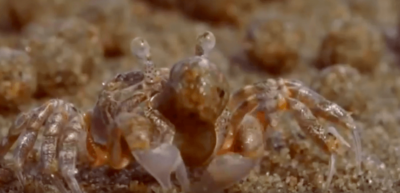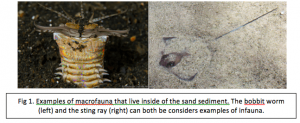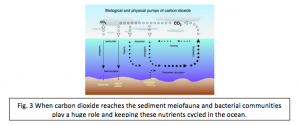
Sand particles can range in size from 0.0625 mm (or 1⁄16 mm) to 2 mm. Despite not being very large there is a whole diversity of an ecosystem within the sediment. Infauna are animals that can be found within these sand grains this differs from animals that live on the benthos or bottom ocean floor in that the infauna actually live within the sediment itself. There are several macrofauna that live within the sediment like the bobbit worms, worms eels, sting rays or take shelter in the sand or even camouflage in the sand. The sand acts as a perfect place to hide from predators or even ambush your prey. Bobbit worms live within the sand sediment and actively hunt fish hiding it’s 3 foot long body under the sand sediment and awaiting for a fish to trigger it. Most specimens of bobbit worms have been up to 3 feet long but some have been found to be even 10 feet! The sand can act as a pretty convenient habitat for a lot of organisms, but too see some of these organisms you have to look even closer.

When you look at the sand even closer, it is revealed that there are even smaller animals that fit inside those small .0625mm to 2mm spaces. These animals consist of the meiofauna which can pass through a 0.5 to a 1mm mesh unharmed. Most of these animals consist of small invertebrates like polychaate worms, nemotodes, arthropods, platyhelminthes, other annelids, and more. The meiofauna are unique in that they have one of the highest species richness and abundance indices. Meiofauna serve as important food resource for deposit feeding animals. A lot of animals such as the sand bubbler crabs or sea cucumbers actively filter out meiofauna living with the sand sediment.
 Meiofauna also serve an important role for breaking down detritus and excrete nutrients that are used by phytobionts and bacteria making them very key for nutrient cycling in the marine ecosystem, determiners of ocean health and ecosystem functioning, and indicators of carbon cycling in the seabed. Because meiofauna are so highly diverse, they can also be key indicators for the effects of global warming on diversity. Studies in Antarctica, a place where rising temperatures show a major affect and change to the habitat, have shown a drop in diversity due to rising ocean temperatures.
Meiofauna also serve an important role for breaking down detritus and excrete nutrients that are used by phytobionts and bacteria making them very key for nutrient cycling in the marine ecosystem, determiners of ocean health and ecosystem functioning, and indicators of carbon cycling in the seabed. Because meiofauna are so highly diverse, they can also be key indicators for the effects of global warming on diversity. Studies in Antarctica, a place where rising temperatures show a major affect and change to the habitat, have shown a drop in diversity due to rising ocean temperatures.

Despite being one of the most diverse, species rich, and abundant ecocsytems on the planet, the meiofauna are actually highly understudied. There is still so much more to know about them and so many more species to potentially discover. With rising ocean temperatures, meiofauna need to be studied before all of that diversity goes away and we must continue to do our part to take care of the ocean and be aware of how pollution from human can affect even the smallest of ecosystems.
Resources:
Sting ray
http://naplesherald.com/2016/06/03/talk-of-the-town-the-stingrays-shuffle/
Carbon Cycle
http://oceansjsu.com/images/exped_ecoystems/CO2_pump_hg.png
Meiofauna diversity image
https://www.researchgate.net/profile/Alexander_Kieneke/publication/260529354/figure/fig3/AS:296899480440839@1447797760980/Representative-meiofauna-of-Little-Cayman-Island-a-A-species-of-Nerillidae-Annelida.png
Meiofauna- life between grains
https://www.youtube.com/watch?v=VW2f2medVXA&t=197s
BBCs Blue planet sand bubbler crab
https://www.youtube.com/watch?v=6XJtq2d_lFs&t=12s
The Chordettes Mr. Sandman
Mp3
Smithsoian channel – bobbit worm
https://www.youtube.com/watch?v=K_7ByiYbCYM
Bobbit worm image
https://static1.squarespace.com/static/5501bec6e4b02c9014d45223/t/566fb0139cadb6b279fc6b71/1450160148406/?format=750w


